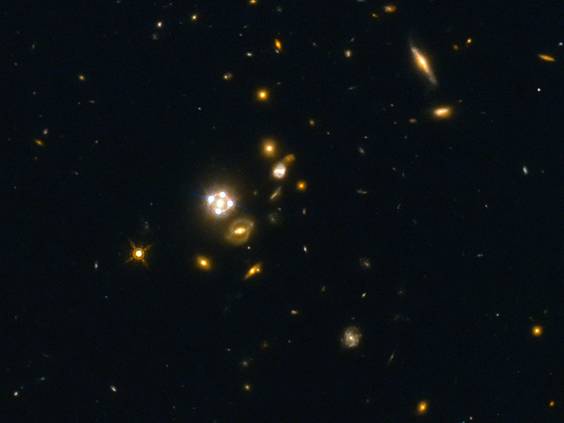26.01.2017
Peeking around cosmic corners
Using galaxies as giant gravitational lenses, an international group of astronomers measured independently how fast the Universe is expanding. The newly measured expansion rate for the local Universe is consistent with earlier findings. These are, however, in intriguing disagreement with measurements of the early Universe. This hints at a fundamental problem at the very heart of our understanding of the cosmos.
The Hubble constant — the rate at which the Universe is expanding — is one of the fundamental quantities describing our Universe. A group of astronomers, the H0LiCOW collaboration (H0 Lenses in COsmograil’s Wellspring), used the NASA/ESA Hubble Space Telescope and other telescopes in space and on the ground to observe five galaxies in order to arrive at an independent measurement of the Hubble constant.
The new measurement is completely independent of — but in excellent agreement with — other measurements of the Hubble constant in the local Universe that used Cepheid variable stars and supernovae as points of reference.
The collaboration is led by Sherry Suyu, who recently moved from the Academia Sinica Institute of Astronomy and Astrophysics (ASIAA) in Taipei (Taiwan) to Garching (Germany) where she works now as a group leader at the Max Planck Institute for Astrophysics and at the Technical University of Munich as a tenure track professor in the Max Planck@TUM program. The group also includes Stefan Hilbert from the Ludwig-Maximilians-Universität Munich who is a junior research group leader at the Excellence Cluster Universe.
A new kind of physics?
However, the value measured by Suyu and her team, as well as those measured using Cepheids and supernovae, are different from the measurement made by the ESA Planck satellite. But there is an important distinction — Planck measured the Hubble constant for the early Universe by observing the cosmic microwave background.
While the value for the Hubble constant determined by Planck fits with our current understanding of the cosmos, the values obtained by the different groups of astronomers for the local Universe are in disagreement with our accepted theoretical model of the Universe.
“The expansion rate of the Universe is now starting to be measured in different ways with such high precision that actual discrepancies may possibly point towards new physics beyond our current knowledge of the Universe,” elaborates Suyu. "Our method is the simplest and most direct way to measure the Hubble constant, since it uses only geometry and relativity, no further assumptions," Stefan Hilbert adds.
Seeing around the corner with gravitational lenses
The targets of the study were massive galaxies positioned between Earth and very distant quasars — incredibly luminous galaxy cores. The light from the more distant quasars is bent around the huge masses of the galaxies as a result of strong gravitational lensing – an effect first predicted by Swiss astronomer Fritz Zwicky 80 years ago. This creates multiple images of the background quasar and its host galaxy, some smeared into extended arcs.
Because galaxies do not create perfectly spherical distortions in the fabric of space and the lensing galaxies and quasars are not perfectly aligned, the light from the different images of the background quasar follows paths which have slightly different lengths.
Since the brightness of quasars changes over time, astronomers can see the different images flicker at different times, the delays between them depending on the lengths of the paths the light has taken. These delays are directly related to the value of the Hubble constant.
Using the accurate measurements of the time delays between the multiple images, as well as computer models, allowed the team to determine the Hubble constant to an impressively high precision: the error is only 3.8 percent. “To reach that accuracy, we even considered the lensing effects of all other nearby galaxies in our analysis,” Stefan Hilbert explains.
“An accurate measurement of the Hubble constant is one of the most sought-after prizes in cosmological research today,” highlights team member Vivien Bonvin, from EPFL, Switzerland. And Suyu adds: “The Hubble constant is crucial for modern astronomy as it can help to confirm or refute whether our picture of the Universe — composed of dark energy, dark matter and normal matter — is actually correct, or if we are missing something fundamental.”
Further information:
Max Planck@TUM: TUM and the Max-Planck-Gesellschaft (MPG) offer a joined career path for highly qualified early career scientists. It combines research as a Max Planck Research Group Leader with a Tenure Track professorship at TUM. For more information, please see here: https://www.tum.de/en/about-tum/working-at-tum/faculty-recruiting/tum-faculty-tenure-track/max-planck-research-group-leaders/
Instruments used: The study used, alongside the NASA/ESA Hubble Space Telescope, the Keck Telescope, ESO’s Very Large Telescope, the Subaru Telescope, the Gemini Telescope, the Victor M. Blanco Telescope, the Canada-France-Hawaii telescope and the NASA Spitzer Space Telescope. In addition, data from the Swiss 1.2-metre Leonhard Euler Telescope and the MPG/ESO 2.2-metre telescope in Chile were used.
Precision of the Hubble constant: The H0LiCOW team determined a value for the Hubble constant of 71.9±2.7 kilometres per second per Megaparsec. In 2016, scientists using the Hubble Space Telescope measured a value of 73.24±1.74 kilometres per second per Megaparsec. In 2015, the ESA Planck Satellite measured the constant with the highest precision so far and obtained a value of 66.93±0.62 kilometres per second per Megaparsec.
Original publications:
This research was presented in a series of papers to appear in the Monthly Notices of the Royal Astronomical Society:
1. Suyu et al.; H0LiCOW I. Program Overview
Submitted to MNRAS, https://arxiv.org/abs/1607.00017
2. Sluse et al.; H0LiCOW II. Spectroscopic survey and galaxy-group identification of the strong gravitational lens system HE0435-1223
Submitted to MNRAS, https://arxiv.org/abs/1607.00382
3. Rusu et al.; H0LiCOW III. Quantifying the effect of mass along the line of sight to the gravitational lens HE 0435-1223 through weighted galaxy counts
Submitted to MNRAS, https://arxiv.org/abs/1607.01047
4. Wong et al.; H0LiCOW IV. Lens mass model of HE 0435-1223 and blind measurement of its time-delay distance for cosmology
Accepted by MNRAS, https://arxiv.org/abs/1607.01403 – DOI: https://dx.doi.org/10.1093/mnras/stw3006
5. Bonvin et al.; H0LiCOW V. New COSMOGRAIL time delays of HE 0435?1223: H0 to 3.8% precision from strong lensing in a flat ?CDM model
Accepted by MNRAS, https://arxiv.org/abs/1607.01790 – DOI: https://dx.doi.org/10.1093/mnras/stw3077
6. Ding et al.; H0LiCOW VI. Testing the fidelity of lensed quasar host galaxy reconstruction
MNRAS (2016) 465 (4): 4634-4649, https://arxiv.org/abs/1610.08504 – DOI: https://dx.doi.org/10.1093/mnras/stw3078
Kontakt
Dr. Stefan Hilbert
Exzellenzcluster Universe
Ludwig-Maximilians-Universität München
Boltzmannstr. 2
85748 Garching
Tel. +49 89 35831-7148
E-Mail: stefan.hilbert@universe-cluster.de
Prof. Dr. Sherry Suyu
Max-Planck-Institut für Astrophysik
Karl-Schwarzschild-Str. 1
85748 Garching
Tel. +49 89 30000-2015
E-Mail: suyu@mpa-garching.mpg.de






